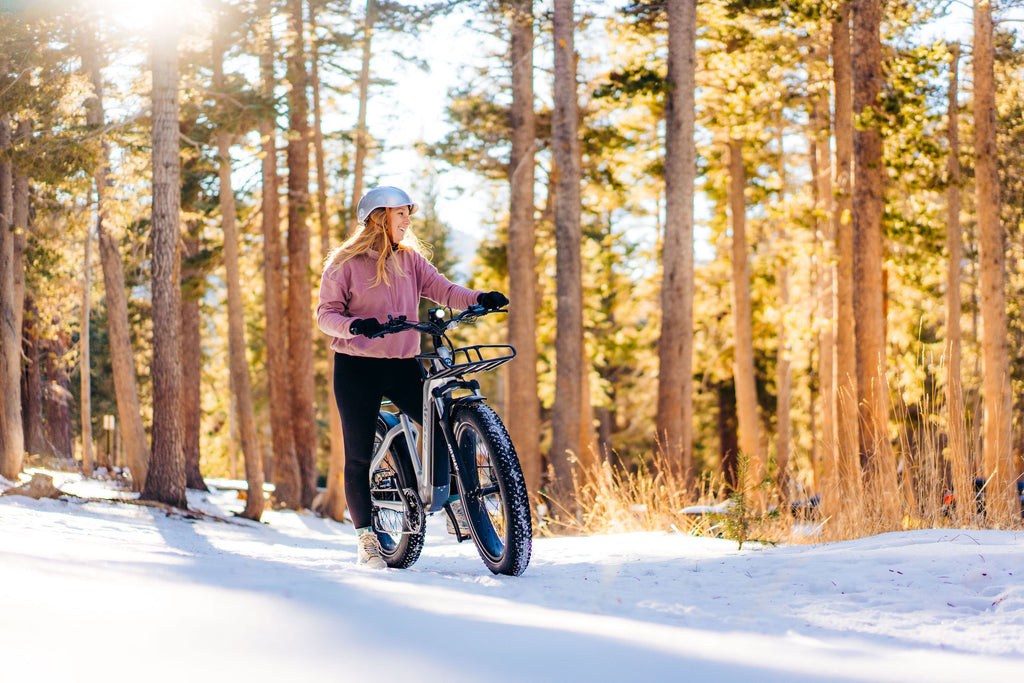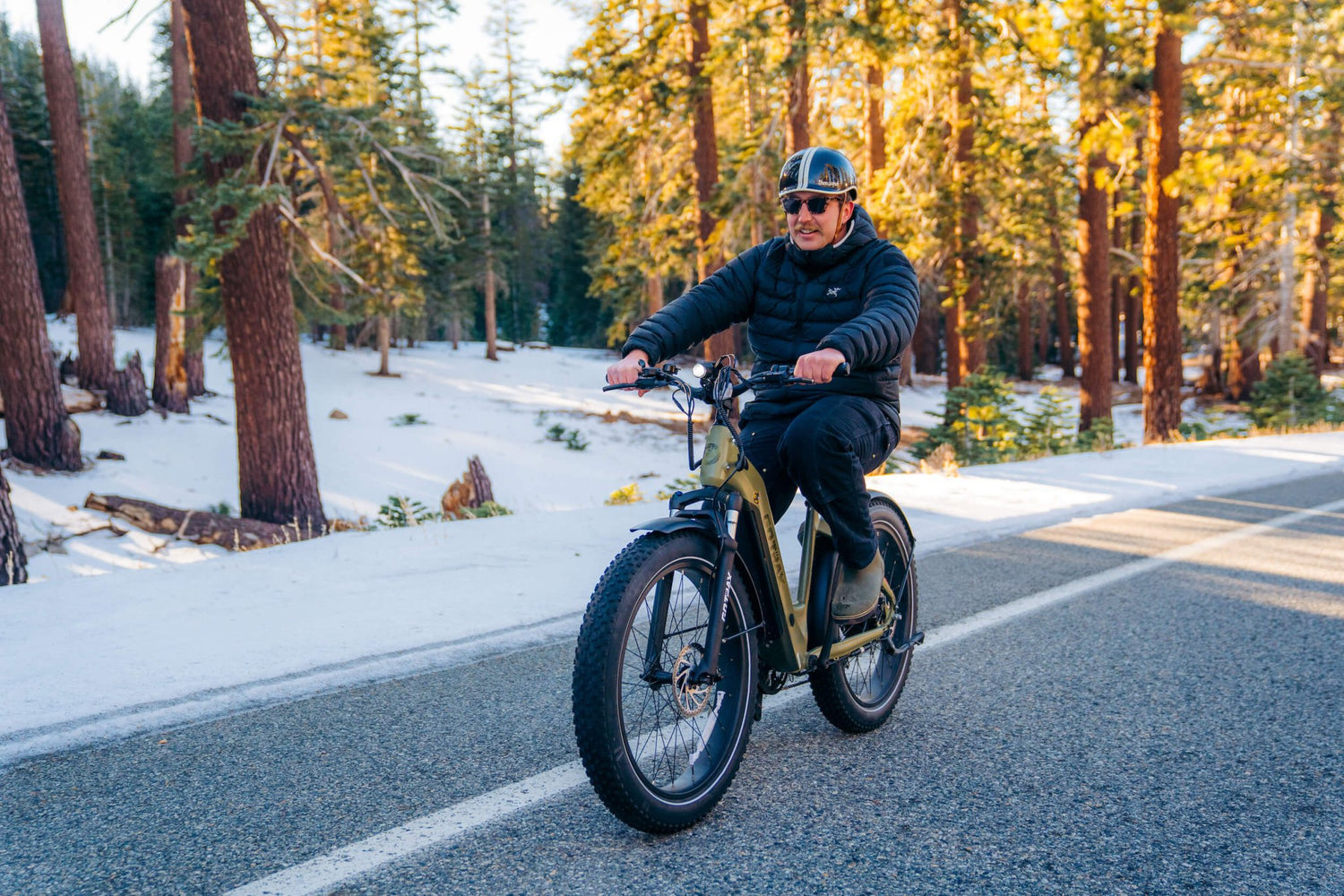Winter is upon us, which means the outdoor conditions for riding are changing. Many new and prospective owners of electric bikes and electric scooters may be concerned about how to properly store and maintain their micro-mobility vehicles this winter. If you want to make the most of your eBike or eScooter during the colder months, check out these important tips and guidelines for protecting your vehicle this winter.
Keep Your Electric Ride Warm
Most people are aware of the dangers of an overheating electronic device, but long-term exposure to the cold actually poses risks to your eScooter or eBike’s battery as well. Keeping your vehicle in freezing temperatures for too long can affect its range; in some cases, it can even damage the battery, controller, or other electronics. This doesn’t mean you shouldn’t use your eBike or eScooter at all: in fact, not using it for a long period of time will actually hurt the battery’s lifespan. Instead, be sure to store your vehicle somewhere safe and warm whenever you’re not using it in the winter months. If your vehicle has a removable battery, keep it indoors for extra protection.
Never charge your eBike or eScooter battery while it’s below freezing. Besides the fact that your battery won’t charge, you could cause permanent damage in the long run. If you need to charge a cold vehicle or battery, bring it somewhere warmer to raise its temperature beforehand. Just don’t let it get too warm; overly hot temperatures aren’t great for electric vehicles either. Batteries prefer a storage area that’s around room temperature, if not just a little bit cooler.
On top of that, if you’re not riding your electric vehicle often, don’t store the battery at full charge or on the charger. Instead, keep somewhere around halfway charged, checking on the battery every so often and recharging it to around half charge if it falls too low. Wherever you store your battery, make sure it isn’t near flammable materials or fire hazards.
Keep Your Electric Ride Dry
Even if your city doesn’t regularly experience freezing temperatures, fall and winter months can bring cold and persistent rainfall. While most of our personal electric vehicles can handle mild rain and splashes, they should not be used or left outside in heavy snow or rainfall, nor should they be exposed to a source of water or other liquids for a significant amount of time. The more severe an eBike or eScooter’s exposure to water is, the higher the risk is for damage to its electronic parts. The non-electrical parts need to be kept dry as well; like other metal products, eBikes and eScooters are prone to rusting if left wet for too long. If you’re planning to keep your vehicle outside, consider investing in a cover to protect it from the elements. In general, try to avoid using your eBike or eScooter during unfavorable weather conditions, and store your vehicle somewhere dry when not in use.

Keep Your Electric Ride Clean
The colder, wetter months of the year cause a greater amount of dirt and grime buildup on all kinds of vehicles, including eBikes and eScooters. The damage done by this dirt is more than just cosmetic: allowing too much muck to cake onto your vehicle can lead to issues in its performance. Gunked-up parts may begin functioning worse, and outside substances can harm electrical parts. Washing your vehicle with water and the occasional bit of soap can help minimize the impact that grime has on your bike or scooter; just remember to fully dry your vehicle afterwards to prevent rust.
Dirt is especially dangerous in the winter for one other reason: it’s salty. The salt that cities lay down on roads during freezing conditions to prevent ice can corrode metal electric vehicle parts if left on for too long. Certain products, such as bike chain lubricant or rust-preventing sprays, can help ward off salt-induced rust, though they don’t entirely eliminate the need for a wash. Be sure to clean your scooter or bike regularly, and check for damage to any of the vehicle’s components while you do so. Being on top of maintenance is key to preserving your eBike or eScooter for as long as possible.
Keep Yourself and Others Safe
Above all else, winter creates conditions that are more hazardous than riders may have experienced in warmer months. Between colder temperatures and slick roads, eBike and eScooter owners face a greater risk of injury to themselves, others, or their vehicles, especially in areas with poor micro-mobility infrastructure. Not only do certain eBikes and eScooters struggle with snow and slush on their paths, but riders may also lose some dexterity in their hands and fingers in the cold, impacting their ability to operate the vehicle’s hand-based controls—including the brakes. Even if they don’t impact a rider’s control of their vehicle, prolonged exposure to the cold can cause injury or illness all on its own, so riders should remember to dress warm and wear clothing with a lot of coverage to protect from the wind.
If you plan to ride consistently through a snowy winter, particularly on an eBike, consider fat or studded tires. Fat tires use their width and low pressure to navigate looser ground, like snow or sand, with ease. Meanwhile, studded tires offer the best possible grip on hard, slick surfaces like ice and packed snow. If your daily commute will take you through this kind of terrain, you’ll want to invest in an e-bike that can support these tire types. Colder weather can impact your tire pressure, so be sure to keep an eye on that as well.
We want all of our riders to enjoy the time they spend with their vehicles, but we also want to make sure you’re safe while you do so. Use caution when riding in conditions that are less than ideal, wear plenty of layers to keep warm and protect yourself from the wind, and if it would be too dangerous to ride, leave your eBike or eScooter at home.

No matter how you decide to ride this winter, these guidelines should help you make the most of your personal electric vehicle while also preserving its lifespan and ensuring the safety of yourself and others. Pay attention to local laws and regulations, and don’t forget to wear a helmet!






